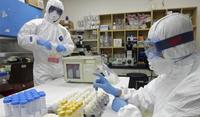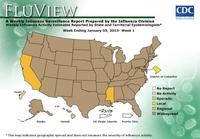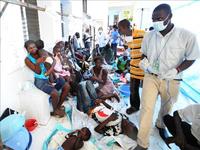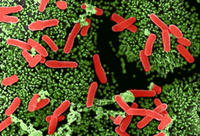-
Preoccupation with bioterrorism hobbles preparations for natural spread of deadly viruses
Preoccupation with hypothetical bioterrorism attacks is leaving America more vulnerable to the threat of natural spread of deadly viruses. Since the 9/11 attacks, the federal government has poured billions of dollars to prevent and monitor threats of bioterrorism, yet the United States was ill-prepared for the swine flu outbreak of 2009. Experts say it is time to rebalance public health priorities so that preparations for the real threat of the outbreak of infectious diseases will not take a back seat to preparations for the more remote threat of bioterrorism.
-
-
Air transportation data helps identify, predict pandemics
Computational model demonstrates how disease spreads in a highly connected world. The computational work has led to a new mathematical theory for understanding the global spread of epidemics. The resulting insights could not only help identify an outbreak’s origin but could also significantly improve the ability to forecast the global pathways through which a disease might spread.
-
-
Facebook, Twitter may yield clues on how to prevent the spread of disease
Cold and flu season prompts society to find ways to prevent the spread of disease though measures like vaccination all the way through to covering our mouths when we cough and staying in bed. These social responses are much more difficult to predict than the way biological contagion will evolve, but new methods are being developed to do just that. Facebook and Twitter could provide vital clues to control infectious diseases by using mathematical models to understand how we respond socially to biological contagions.
-
-
Remote satellites-based early warning system for cholera epidemics

Researchers have established new techniques – based on remote satellites imagery — for predicting the severity of seasonal cholera epidemics months before they occur and with a greater degree of accuracy than other methods based on remote satellite imaging. The findings of the research may provide the essential lead time to strengthen intervention efforts before the outbreak of cholera in endemic regions.
-
-
Effective screening of airline passengers arriving from areas of infectious disease outbreaks
New study shows that exit-screening at thirty-six airports would have assessed all air travelers at risk of transporting H1N1 out of Mexico at start of 2009 pandemic. Screening at 99 percent of the world’s international airports could have been forgone with negligible missed opportunities to prevent or delay the spread of disease. Screening at just eight airports worldwide would have led to the assessment of 90 percent of all at-risk air travelers.
-
-
Controlling contagion by restricting mobility
In an epidemic or a bioterrorist attack, the response of government officials could range from a drastic restriction of mobility — imposed isolation or total lockdown of a city — to moderate travel restrictions in some areas or simple suggestions that people remain at home. Deciding to institute any measure would require officials to weigh the costs and benefits of action, but at present there is little data to guide them on the question of how disease spreads through transportation networks. A new MIT study shows that in the face of an epidemic, even moderate government-mandated travel restrictions would slow contagion.
-
-
International partnership tries to preempt next global pandemic
Researchers from Australia, Singapore, and the United States are joining forces, through a $20 million partnership, to help pre-empt and prepare the world for the next human pandemic.
-
-
Mass religious gatherings in Middle East increase risk of MERS coronavirus spreading globally
Researchers say that the life-threatening MERS coronavirus which has emerged in the Middle East could spread faster and wider during two international mass gatherings involving millions of people in the next few months – the umrah pilgrimage and the hajj. The researchers describe the most likely pathways of international spread based upon worldwide patterns of air travel.
-
-
Potential flu pandemic looms
In the summer of 1968, a new strain of influenza appeared in Hong Kong. This strain, known as H3N2, spread around the globe and eventually killed an estimated one million people. A new study reveals that there are many strains of H3N2 circulating in birds and pigs that are genetically similar to the 1968 strain and have the potential to generate a pandemic if they leap to humans.
-
-
New bird flu strain adapting to mammals, humans
Influenza virus depends on its ability to attach to and commandeer the living cells of its host to replicate and spread efficiently. Avian influenza rarely infects humans, but can sometimes adapt to people, posing a significant risk to human health. A genetic analysis of the avian flu virus responsible for at least nine human deaths in China portrays a virus evolving to adapt to human cells, raising concern about its potential to spark a new global flu pandemic.
-
-
New, drug-resistant pandemic swine flu may go global

Health experts in Australia have expressed concerned about the threat of a new type of drug-resistant pandemic flu which is circulating in the population at large. These experts say that the new strain of swine flu has learned how to dodge the antiviral Tamiflu. While it is still rare, it is now spreading outside of hospitals. U.K. health officials, who have already recorded eight cases of the new strain in the United Kingdom, agree with their Australian counterparts that the new virus has the potential to turn global.
-
-
CDC: Severe flu strain spreading across U.S.

According to the Center for Disease Control(CDC), thirty states are reporting high levels of flu-like illnesses. The flu going around this year is called HN32, and this strain is likely to keep people ill for longer periods than other strains.
-
-
Conquering cholera in Haiti without vaccinating most people

The Centers for Disease Control and Prevention has been skeptical about the effectiveness of vaccination against cholera in Haiti; it has instead emphasized cleaning up the water supply and improving sanitation as the best ways to check the spread of the disease; a new study suggests that vaccination would be effective, and that cholera could be contained in Haiti by vaccinating less than half the population
-
-
Pigs in southern China found to be infected with avian flu

Researchers report for the first time the seroprevalence of three strains of avian influenza viruses in pigs in southern China, but not the H5N1 avian influenza virus; their research has implications for efforts to protect the public health from pandemics
-
-
Bugs without borders: epidemics spread as bugs acquire resistance to antibiotic

Researchers show that the global epidemic of Clostridium difficile 027/NAP1/BI in the early to mid-2000s was caused by the spread of two different but highly related strains of the bacterium rather than one as was previously thought; the spread and persistence of both epidemics were driven by the acquisition of resistance to a frontline antibiotic
-
- All
- Regional
- Water
- Biometrics
- Borders/Immig
- Business
- Cybersecurity
- Detection
- Disasters
- Government
- Infrastructure
- International
- Public health
- Public Safety
- Communication interoperabillity
- Emergency services
- Emergency medical services
- Fire
- First response
- IEDs
- Law Enforcement
- Law Enforcement Technology
- Military technology
- Nonlethal weapons
- Nuclear weapons
- Personal protection equipment
- Police
- Notification /alert systems
- Situational awareness
- Weapons systems
- Sci-Tech
- Sector Reports
- Surveillance
- Transportation
Advertising & Marketing: advertise@newswirepubs.com
Editorial: editor@newswirepubs.com
General: info@newswirepubs.com
2010-2011 © News Wire Publications, LLC News Wire Publications, LLC
220 Old Country Road | Suite 200 | Mineola | New York | 11501
Permissions and Policies
Editorial: editor@newswirepubs.com
General: info@newswirepubs.com
2010-2011 © News Wire Publications, LLC News Wire Publications, LLC
220 Old Country Road | Suite 200 | Mineola | New York | 11501
Permissions and Policies
